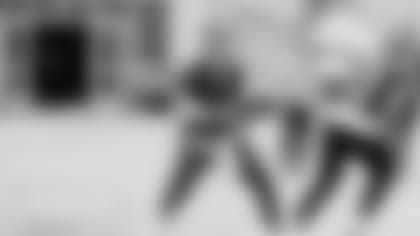Eric Reid seemed to know what was coming. Just a few hours before the start of mandatory minicamp, the San Francisco 49ers safety was explaining to reporters why it's so difficult to defend Kyle Shanahan's offense.
Shanahan's ability to disguise plays was one of Reid's deductions. The coach's knack for setting up other plays was another.
Reid's conclusions work hand-in-hand. Shanahan prides himself on making run plays look like pass plays. In turn, when a defense is keying on the running game, for example, he knows how to turn that aggressiveness into an explosive play in the passing game.
Sure enough, the 49ers offense exploited the defense for two huge gains on play-action during practice shortly after Reid's presser. The first came up the right seam to rookie tight end George Kittle, and the second was a 50-yard bomb to Marquise Goodwin.
"There are certain ways you put teams in a bind," Shanahan said. "You make them stop the run, and then you know you have the play-action or you have a bootleg or something like that. There are ways to take pressure off the O-Line and off the quarterback. It helps you get some easier explosive plays, not just dropping back all the time and needing your quarterback to be unbelievable and the protection and everything."
Keeping the defense honest and off-balance is the 60-minute chess match on gameday.
So just how much does Shanahan rely on play-action? According to Pro Football Focus, Atlanta Falcons quarterback Matt Ryan used a play fake on 27.7 percent of his dropbacks last season, easily the most of any NFL quarterback.
The constant threat of play-action forces linebackers to make quick decisions between their assignments – pounce on the running play or make sure you're in the right spot in pass coverage.
"If he's not stopping the run because he's so worried about the receiver and quarterback, now you're getting four yards before that guy shows up," Shanahan said. "It makes people hesitate. If you let a defense tee off in this league, I don't care who it is or who you are on offense, they're usually going to get after you once you become one dimensional."
That sounds simple enough, but it all goes back to being able to disguise your plays. The play fake is moot if the offense can't sell it. Everything has to look the exact same as if it were truly a running play.
And play-action is sold almost entirely by the offensive line. That's the common misconception. Pierre Garçon explained that's why the fake itself, when the quarterback keeps the ball instead of handing it to the running back, is largely irrelevant.
"I think the general fan probably thinks it's all between the running back and the quarterback, and I would say the majority of it is done by the offensive line," Hoyer said. "When the offensive line comes off like it's the run, you can see times where the linebackers are reacting to them. They're not even looking at us. They're looking at the offensive line's intention as well as the fullback and the tight end."
The 49ers have nowhere to go but up in terms of proficiency in the passing game. San Francisco ranked dead last in passing yards last season. If Shanahan can turn things around in 2017, finding success with play-action will be a big reason why.





